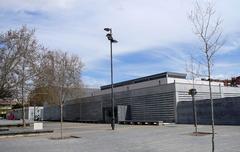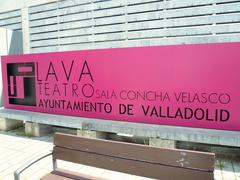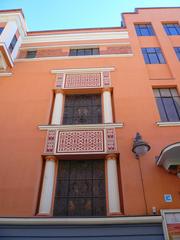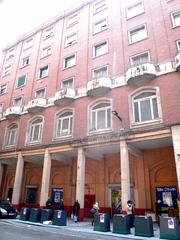
Santa Cruz Palace Valladolid: Visiting Hours, Tickets, and Historical Sites Guide
Date: 04/07/2025
Introduction: History and Significance
Nestled in the heart of Valladolid, Spain, the Santa Cruz Palace (Palacio de Santa Cruz) stands as a landmark of the Spanish Renaissance and a testament to the city’s long-standing tradition of education, culture, and political significance. Commissioned in the late 15th century by Cardinal Pedro González de Mendoza, this palace was originally built as the Colegio Mayor de Santa Cruz—an institution pivotal to the spread of humanist ideals and academic excellence in Castile. Designed by architect Lorenzo Vázquez de Segovia, the palace seamlessly blends Gothic and early Renaissance elements, marking a turning point in Spanish architectural history (Ultimate 3-Day Valladolid Itinerary; Revigorate).
Today, the palace remains a vibrant hub, serving as the seat of the University of Valladolid’s Vice Chancellor, home to the Arellano Alonso Museum of African Art, and a venue for cultural events and exhibitions. Its harmonious façades, elegant courtyards, and rich collections offer a unique window into Spain’s Renaissance legacy and the ambitions of the Catholic Monarchs (Portal de Turismo de Castilla y León; Fundación Jiménez-Arellano Alonso).
This guide provides detailed information on the palace’s history, architecture, visiting hours, tickets, accessibility, travel tips, and nearby attractions—essential for anyone planning to experience the best of Valladolid’s historic heritage (The Crazy Tourist; Bezzia).
Table of Contents
- Origins and Early History
- Architectural Significance
- Historical Figures and Events
- Role in Spanish and Local History
- Visiting Santa Cruz Palace
- Preservation and Current Use
- Frequently Asked Questions
- Conclusion
- Plan Your Visit
Origins and Early History
Santa Cruz Palace is recognized as one of Spain’s earliest examples of Renaissance architecture. Construction began in 1486 under Cardinal Pedro González de Mendoza, who aimed to create an academic institution promoting Renaissance humanism. Initially designed with Gothic elements, the palace’s architecture soon integrated Renaissance features inspired by Italy, reflecting the cultural shifts of late 15th-century Castile (Ultimate 3-Day Valladolid Itinerary; Explore Valladolid).
As the headquarters for the Colegio Mayor de Santa Cruz, the palace educated generations of scholars, many of whom shaped Spain’s religious, political, and intellectual life.
Architectural Significance
Lorenzo Vázquez de Segovia’s design introduced Renaissance principles to Spain, blending symmetry, classical columns, and balanced proportions with local traditions (Ars Artística Adventure of Mankind). The palace features a monumental façade with pilasters and a classical entablature, a spacious courtyard framed by arcaded galleries, and intricate heraldic decorations. Its three-story courtyard, robust stonework, and elegant galleries set a precedent for Spanish Renaissance architecture (Revigorate).
Historical Figures and Events
The palace played a central role in Valladolid’s intellectual and political scene, especially when the city served as the Spanish capital under Philip III (1601–1606). The Colegio Mayor de Santa Cruz attracted students from across Castile, producing influential clergy, administrators, and scholars (Historical Valladolid). Despite periods of decline and secularization, the palace has endured as a symbol of academic excellence and civic pride.
Role in Spanish and Local History
Santa Cruz Palace contributed significantly to the development of higher education and the spread of Renaissance humanism in Spain. Its college emphasized classical studies, theology, and philosophy, mirroring trends across Europe. Today, the palace remains integral to Valladolid’s identity, housing the University of Valladolid’s leadership and hosting cultural activities (Valladolid University History).
Visiting Santa Cruz Palace: Practical Information
Visiting Hours
- General Opening: Monday to Friday, 10:00 AM–2:00 PM
- Museum Hours: Tuesday to Sunday, 10:00 AM–6:00 PM (Arellano Alonso Museum)
- Closed: Public holidays, including December 24, 25, 31, and January 1, 6
- Tip: Hours may vary for special events—check the official website before your visit.
Tickets and Entry
- Main Courtyard/Public Areas: Free entry
- Exhibitions/Museum: €5 or less; discounts for students/seniors/groups
- Purchase: On-site or online via the foundation’s website
Guided Tours
Guided tours offer in-depth insight into the palace’s history and architecture. Tours are primarily in Spanish, with occasional English options, and can be booked in advance through the museum or local tourism office.
Accessibility
- Main Areas: Wheelchair accessible with ramps and elevators
- Historic Sections: Some upper floors may have limited access
- Assistance: Contact visitor services in advance if you have specific needs
Travel Tips
- Best Time to Visit: Spring (April–June) and autumn (September–October)
- Duration: Allow 1–2 hours for a comprehensive visit
- Photography: Allowed in public spaces (no flash/tripods); restrictions in the chapel/exhibitions
- Language: Most tours and signage in Spanish, some English materials available
- Safety: The area is safe, but keep valuables secure
Nearby Attractions
Combine your visit with these nearby sites:
- National Sculpture Museum
- Valladolid Cathedral
- Church of Saint Mary the Ancient
- Plaza Mayor
- Campo Grande Park
- Pasaje Gutiérrez (Bezzia; Flytrippers)
Preservation and Contemporary Use
Santa Cruz Palace is a protected heritage site, with ongoing restoration efforts safeguarding its architectural and historical integrity. It continues to function as the administrative center for the University of Valladolid and as a cultural venue, hosting exhibitions, academic conferences, and events (Portal de Turismo de Castilla y León; Barceló Pin and Travel).
Frequently Asked Questions (FAQs)
Q: What are the Santa Cruz Palace opening hours?
A: Monday–Friday, 10:00 AM–2:00 PM; museum Tuesday–Sunday, 10:00 AM–6:00 PM. Closed on major holidays.
Q: How much does admission cost?
A: General entry is free; museum/exhibition tickets cost up to €5, with discounts available.
Q: Are guided tours available?
A: Yes, in Spanish with occasional English tours. Book through the museum or tourism office.
Q: Is the palace wheelchair accessible?
A: Most main areas are accessible; some historic upper floors may not be.
Q: Can I take photos?
A: Yes, in public areas; restrictions apply in exhibitions and the chapel.
Q: Where is Santa Cruz Palace located?
A: Plaza de Santa Cruz, Valladolid, near major attractions and easily reached by public transport (Turismo Castilla y León).
Visuals and Interactive Elements
Explore high-quality images and virtual tours on the foundation’s website. Maps and downloadable guides are available to enhance your visit.
Conclusion
Santa Cruz Palace is a cornerstone of Valladolid’s historical and cultural landscape. Its pioneering Renaissance architecture, academic heritage, and dynamic cultural offerings make it an essential destination for any visitor. Plan your experience by checking updated visiting hours, ticket details, and upcoming exhibitions, and consider exploring nearby attractions for a well-rounded Valladolid itinerary.
Plan Your Visit and Stay Connected
Download the Audiala app for real-time updates, guided tours, and exclusive content. Follow us on social media for the latest news on events, exhibitions, and travel tips for Santa Cruz Palace and Valladolid’s other historical treasures.
Related Articles
References
- Ultimate 3-Day Valladolid Itinerary
- Explore Valladolid
- Valladolid Travel Guide
- Revigorate
- Ars Artística Adventure of Mankind
- Portal de Turismo de Castilla y León
- Barceló Pin and Travel
- Fundación Jiménez-Arellano Alonso
- The Crazy Tourist
- Bezzia
- Wikipedia
- Flytrippers
- Wanderlog







